
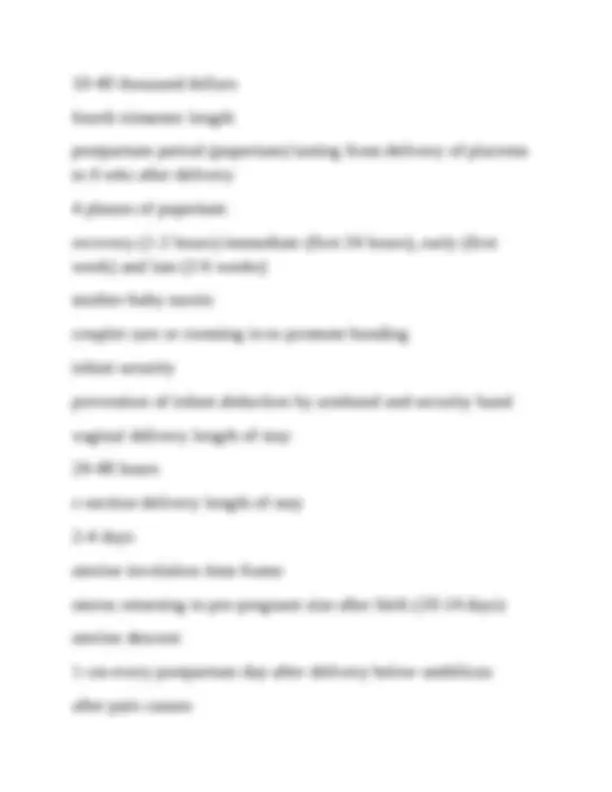
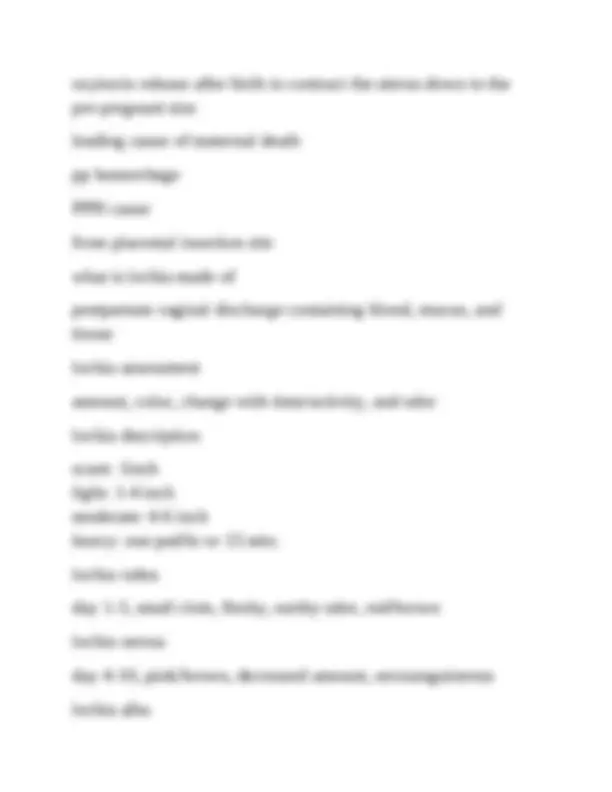
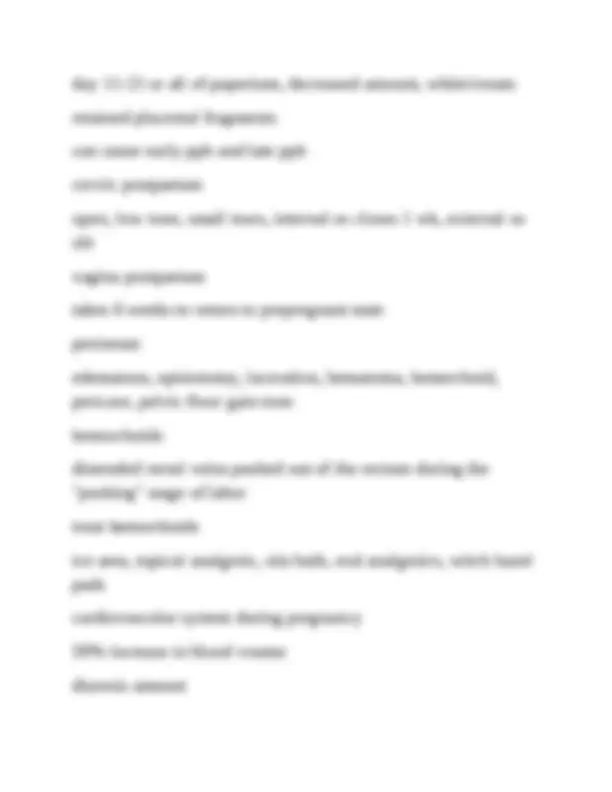
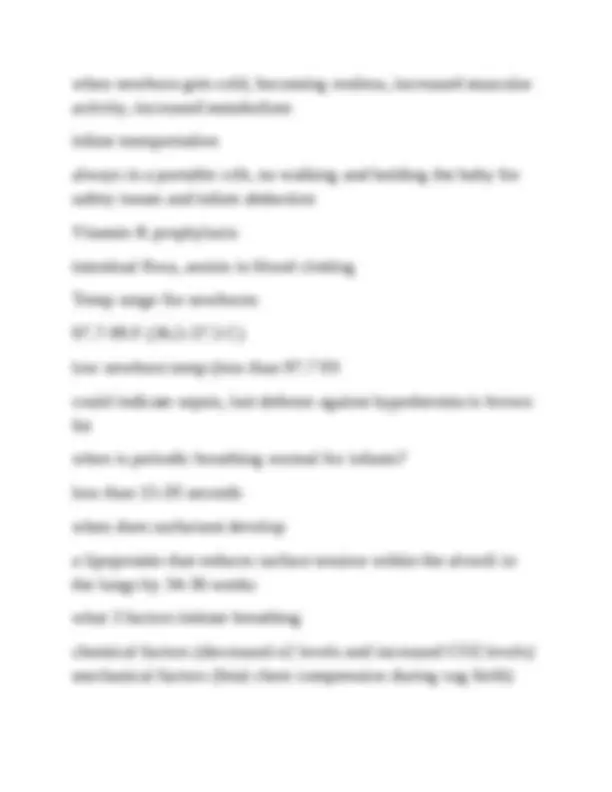
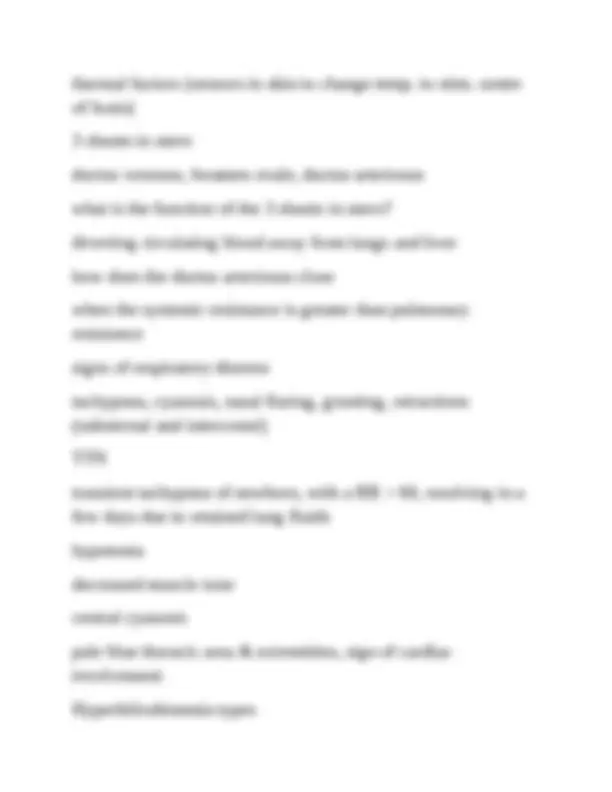
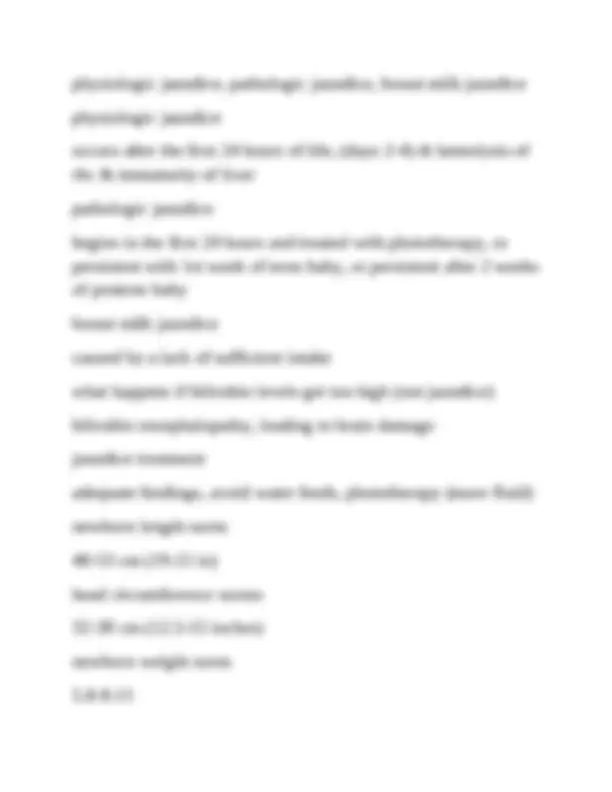
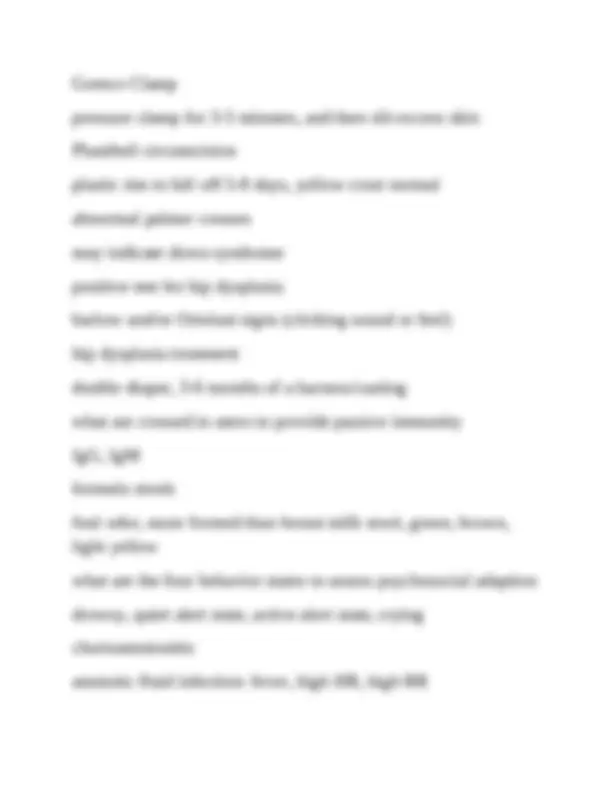
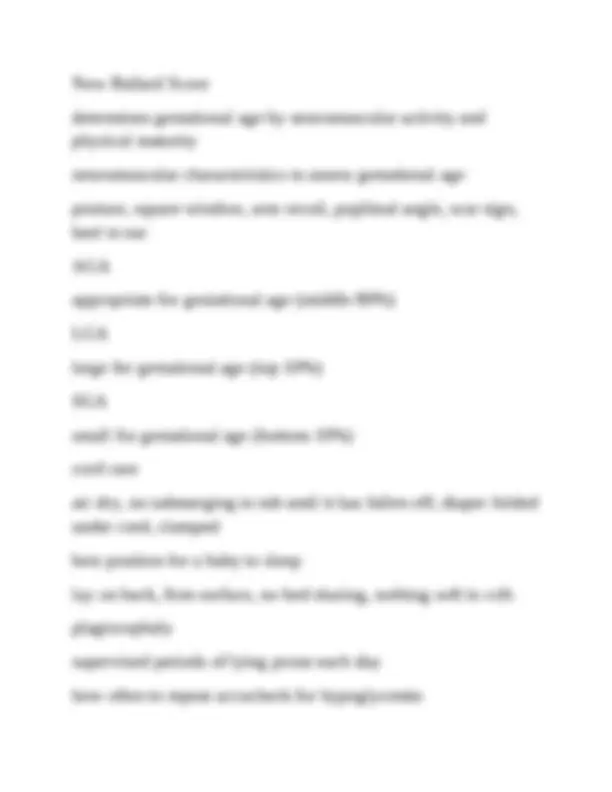
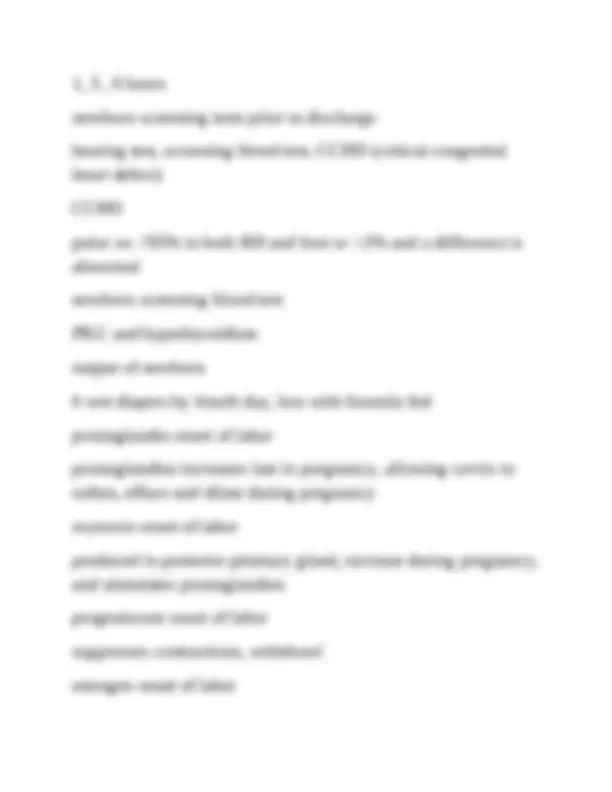
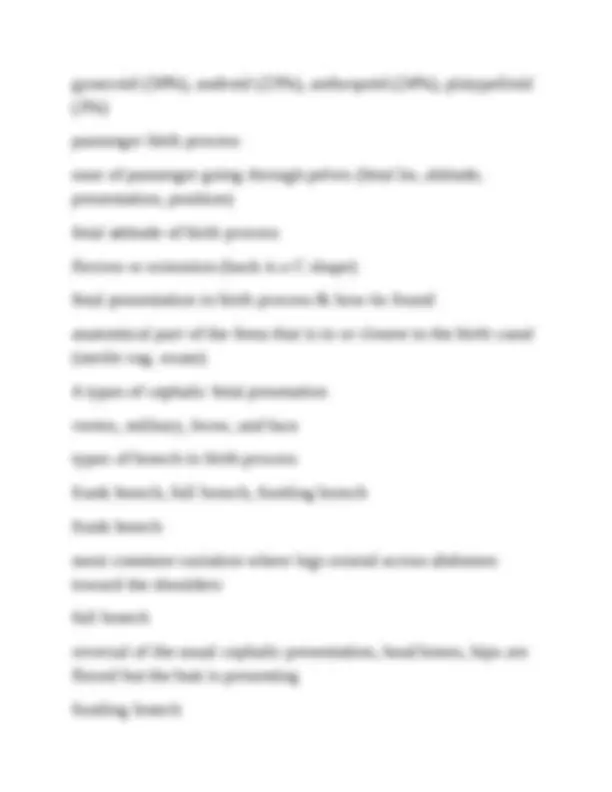
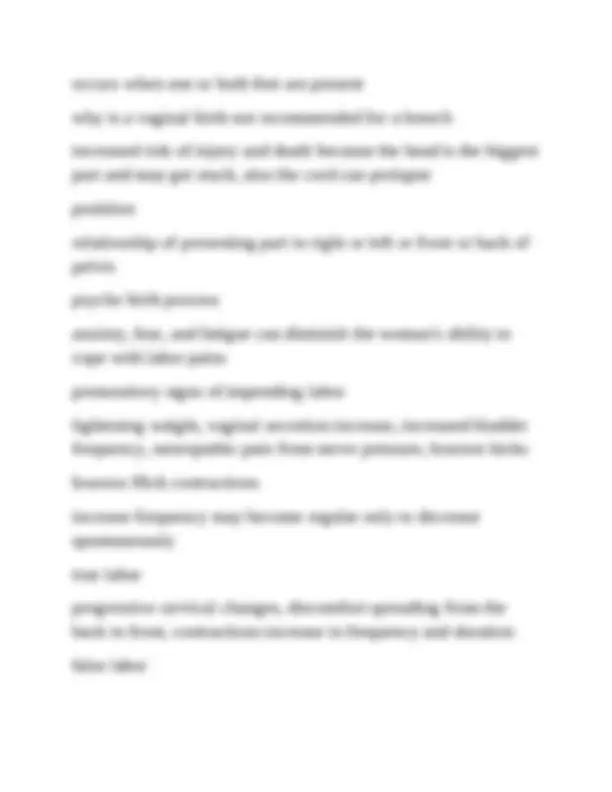
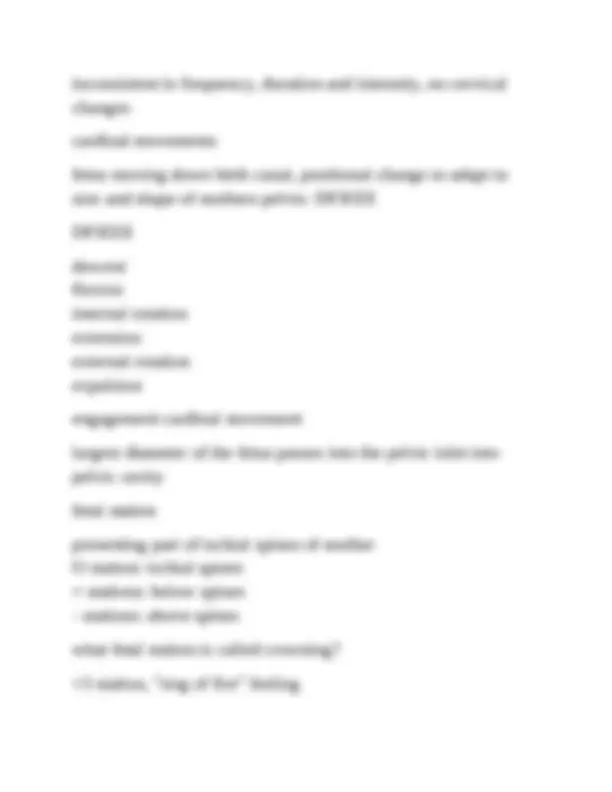
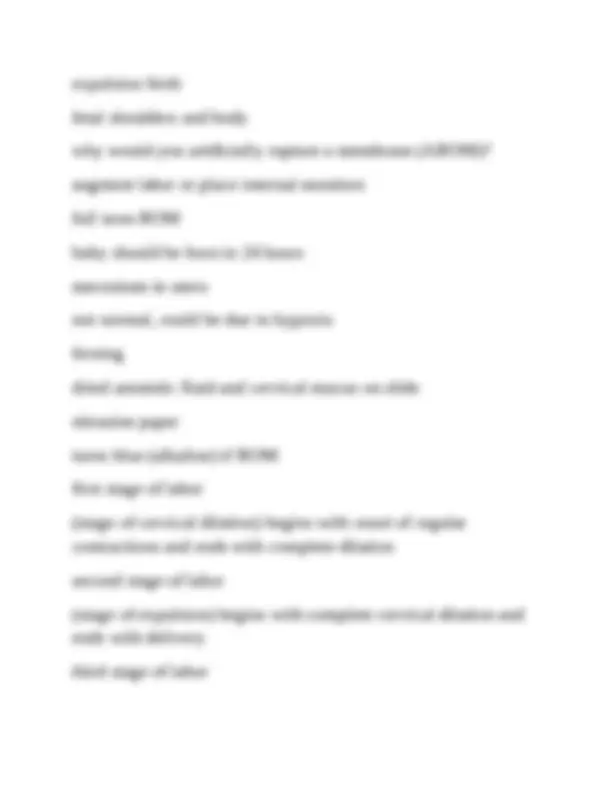
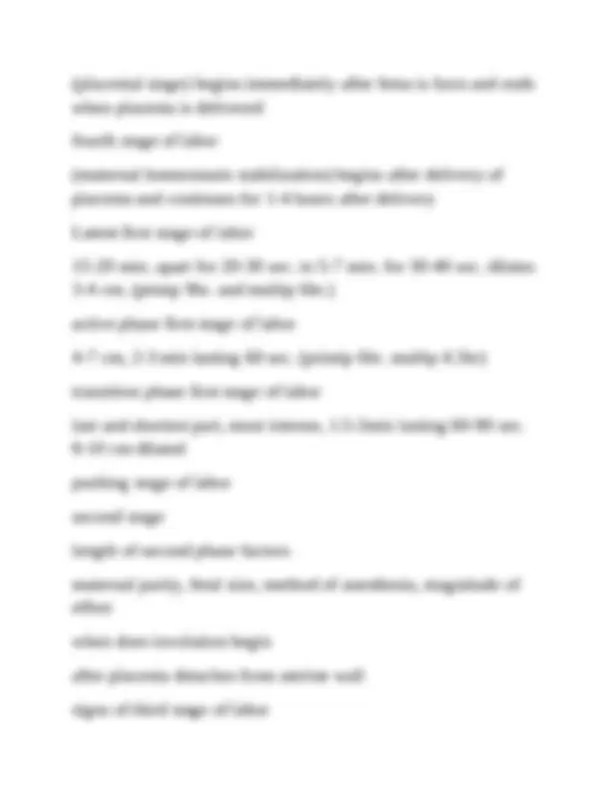
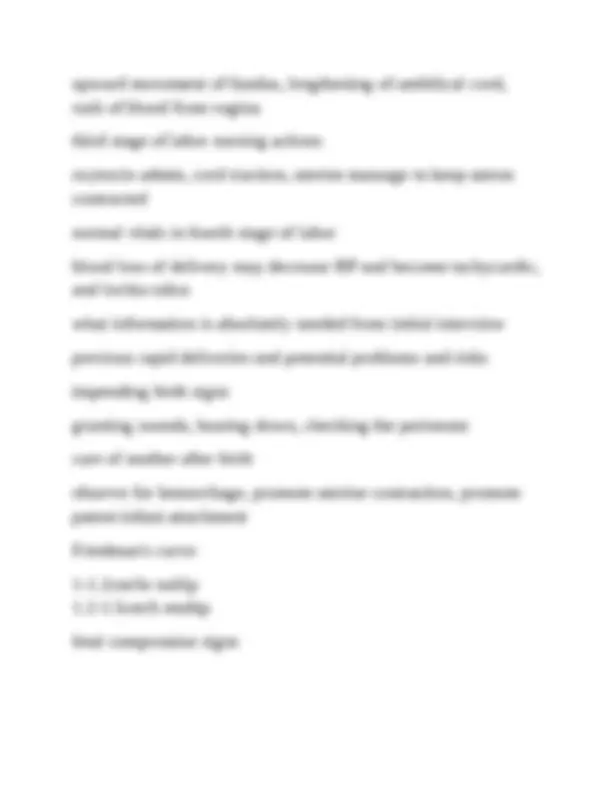
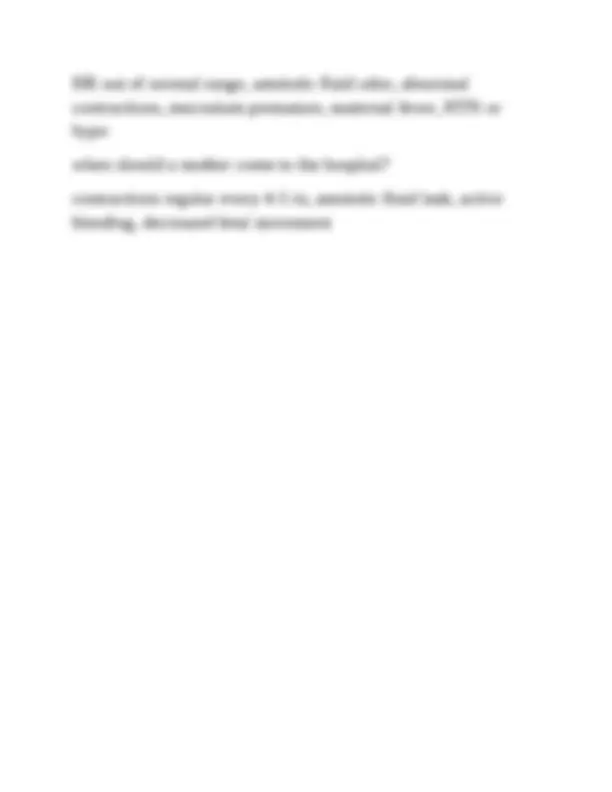


Study with the several resources on Docsity

Earn points by helping other students or get them with a premium plan


Prepare for your exams
Study with the several resources on Docsity

Earn points to download
Earn points by helping other students or get them with a premium plan
Community
Ask the community for help and clear up your study doubts
Discover the best universities in your country according to Docsity users
Free resources
Download our free guides on studying techniques, anxiety management strategies, and thesis advice from Docsity tutors
N354 Exam 1 SDSU Questions With Complete Solutions
Typology: Exams
1 / 24

This page cannot be seen from the preview
Don't miss anything!

















N354 Exam 1 SDSU Questions With Complete Solutions Doula Labor support person Granny Midwives majority of births attended by midwives Maternal Mortality Causes hemorrhage, infection, embolism, HTN Infant Mortality Causes Congenital malformations, SIDS, maternal complication, LBW Hemorrhage intervention oxytocin sepsis intervention septic delivery, antibiotics Eclampsia magnesium sulfate obstructed labor cesarean birth Title V of the Social Security Act
provides funds from maternal-child programs National Institute of Child Health and Human Development Supports research and education of personnel needed for maternal and child health programs Title V amendment to the public services act established maternal and infant care project to provide comprehensive prenatal and infant care in public clinics Head Start (maternal-child care) provides educational opportunities for low income children or preschool age National center for Family Planning A clearinghouse for contraceptive information WIC program provides supplemental food & education and funding to eligible families DRG's standard set by the federal government for amount of money allotted for each individual diagnosis Vaginal delivery cost 3-10 thousand dollars C-section delivery cost
oxytocin release after birth to contract the uterus down to the pre-pregnant size leading cause of maternal death pp hemorrhage PPH cause from placental insertion site what is lochia made of postpartum vaginal discharge containing blood, mucus, and tissue lochia assessment amount, color, change with time/activity, and odor lochia description scant: 1inch light: 1-4 inch moderate: 4-6 inch heavy: one pad/hr or 15 min. lochia rubra day 1-3, small clots, fleshy, earthy odor, red/brown lochia serosa day 4-10, pink/brown, decreased amount, serosanguineous lochia alba
day 11-21 or all of puperium, decreased amount, white/cream retained placental fragments can cause early pph and late pph cervix postpartum open, low tone, small tears, internal os closes 1 wk, external os slit vagina postpartum takes 6 weeks to return to prepregnant state perineum edematous, episiotomy, laceration, hematoma, hemorrhoid, pericare, pelvic floor gain tone hemorrhoids distended rectal veins pushed out of the rectum during the "pushing" stage of labor treat hemorrhoids ice area, topical analgesic, sitz bath, oral analgesics, witch hazel pads cardiovascular system during pregnancy 50% increase in blood voume diuresis amount
a full bladder interferes with uterine contractility and can result in hemorrhage when should the mother be able to urinate? 4 hours after delivery methods of heat production increased activity, flexion, metabolism, vasoconstriction, nonshivering thermogenesis: leading to increased oxygen, glucose and cause resp. distress, hypoglycemia, and jaundice hypothermia signs mottling, acrocyanosis, bradycardia, tachypnea, apnea, lethargy, hypotonia, and poor feeding hyperthermia signs flushing, hypotension, diaphoresis, tachypnea, tachycardia, apnea, irritability, poor feeding brain account for total oxygen consumption in infacts 40%, and roughly that proportion of body heat increase metabolism on temp. increased temp. as well as the need for oxygen brown fat metabolism releases fatty acids: metabolic acidosis cold stress of infant
when newborn gets cold, becoming restless, increased muscular activity, increased metabolism infant transportation always in a portable crib, no walking and holding the baby for safety issues and infant abduction Vitamin K prophylaxis intestinal flora, assists in blood clotting Temp range for newborns 97.7-99 F (36.5-37.5 C) low newborn temp (less than 97.7 F could indicate sepsis, last defense against hypothermia is brown fat when is periodic breathing normal for infants? less than 15-20 seconds when does surfactant develop a lipoprotein that reduces surface tension within the alveoli in the lungs by 34-36 weeks what 3 factors initiate breathing chemical factors (decreased o2 levels and increased CO2 levels) mechanical factors (fetal chest compression during vag birth)
physiologic jaundice, pathologic jaundice, breast milk jaundice physiologic jaundice occurs after the first 24 hours of life, (days 2-4) dt hemolysis of rbc & immaturity of liver pathologic jaundice begins in the first 24 hours and treated with phototherapy, or persistent with 1st week of term baby, or persistent after 2 weeks of preterm baby breast milk jaundice caused by a lack of sufficient intake what happens if bilirubin levels get too high (not jaundice) bilirubin encephalopathy, leading to brain damage jaundice treatment adequate feedings, avoid water feeds, phototherapy (more fluid) newborn length norm 48-53 cm (19-21 in) head circumference norms 32-38 cm (12.5-15 inches) newborn weight norm 5.8-8.
newborn face CN observation CN VII damage due to traumatic birth or forceps when does the anterior fontanel close 18 months when does the posterior fontanel close 2-4 months causes of head swelling caput, heamtoma, subgaleal hemorrhage Caput Succedaneum swelling of soft tissues, crossing suture line cephalohematoma blood accumulation between skull and periosteum, does not cross suture line subgaleal hemorrhage emissary veins rupture, fluid pooling visual field assessment for eyes 10-12 inches from face eye color for newborns 9 months until final color
Gomco Clamp pressure clamp for 3-5 minutes, and then slit excess skin Plastibell circumcision plastic rim to fall off 5-8 days, yellow crust normal abnormal palmer creases may indicate down syndrome positive test for hip dysplasia barlow and/or Ortolani signs (clicking sound or feel) hip dysplasia treatment double diaper, 3-6 months of a harness/casting what are crossed in utero to provide passive immunity IgG, IgM formula stools foul odor, more formed than breast milk stool, green, brown, light yellow what are the four behavior states to assess psychosocial adaption drowsy, quiet alert state, active alert state, crying chorioamnionitis amniotic fluid infection: fever, high HR, high RR
New Ballard Score determines gestational age by neuromuscular activity and physical maturity neuromuscular characteristics to assess gestational age posture, square window, arm recoil, popliteal angle, scar sign, heel to ear AGA appropriate for gestational age (middle 80%) LGA large for gestational age (top 10%) SGA small for gestational age (bottom 10%) cord care air dry, no submerging in tub until it has fallen off, diaper folded under cord, clamped best position for a baby to sleep lay on back, firm surface, no bed sharing, nothing soft in crib plagiocephaly supervised periods of lying prone each day how often to repeat accucheck for hypoglycemia
promotes oxytocin production and estrogen receptors in uterine muscles coordinated contrractions begin in uterus fundus and spread down towards cervix to propel fetus through involuntary contractions not under conscious control, mother cannot cause labor intermittent contrations not sustained and allows relaxation of uterine muscles three phases of the contraction cycle increment acme decrement increment occurs at the contraction begins at the fundus acme peak where contraction is most intense decrement period of decreasing intensity opposing force of upper uterus
contractions push fetus down, and pulls the cervix opened when is the best time to assess the mothers vitals while contracting between contractions why do you avoid large amounts of sugar for a laboring mother rebound hypoglycemia in the newborn when the sugar supply abruptly ends at birth urinary system reduced sensation during labor intense contractions or effect of pain management, woman are unaware of a full bladder fetal protective mechanisms in placental circulation fetal hemoglobin. high hematocrit, high CO 5 component affecting the birth process power, passage, passenger, position, psyche primary power vs secondary power birth process primary is involuntary uterine contractions and secondary is mother intentional effort to push out fetus passage birth process passage for birth of fetus by pelvis and tissue: inlet, midpelvis, outlet 4 basic types of pelvis
occurs when one or both feet are present why is a vaginal birth not recommended for a breech increased risk of injury and death because the head is the biggest part and may get stuck, also the cord can prolapse posititon relationship of presenting part to right or left or front or back of pelvis psyche birth process anxiety, fear, and fatigue can diminish the woman's ability to cope with labor pains premonitory signs of impending labor lightening weight, vaginal secretion increase, increased bladder frequency, neuropathic pain from nerve pressure, braxton hicks braxton Hick contractions increase frequency may become regular only to decrease spontaneously true labor progressive cervical changes, discomfort spreading from the back to front, contractions increase in frequency and duration false labor
inconsistent in frequency, duration and intensity, no cervical changes cardinal movements fetus moving down birth canal, positional change to adapt to size and shape of mothers pelvis: DFIEEE DFIEEE descent flexion internal rotation extension external rotation expulsion engagement cardinal movement largest diameter of the fetus passes into the pelvic inlet into pelvic cavity fetal station presenting part of ischial spines of mother O station: ischial spines